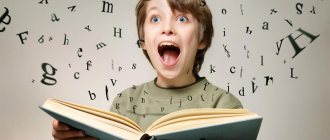Article - Types of written speech disorders and recommendations for their correction.
Types of writing disorders and recommendations for their correction.
Writing skill has great social significance. In our culture, learning is impossible with unformed writing. We all know that from primary school to university entrance exams, the ability to write correctly is very important. In this case, we are not talking about the formation or unformation of a function, but about a sufficiently high level of proficiency in writing skills.
The problem and correction of specific disorders of written speech, i.e. dysgraphia has always been relevant.
The main task of a speech therapist at a school speech center is the timely identification and prevention of writing and reading disorders.
What is dysgraphia?
Dysgraphia is a partial disorder of the writing process, manifested in persistent, repeated errors caused by the immaturity of the higher mental functions involved in the writing process.
What should a teacher be wary of in students’ oral and written speech:
• incorrect pronunciation of sounds, which can subsequently cause dysgraphia and dyslexia;
• special nature of errors in writing:
- errors are not the rule;
- persistent errors that do not disappear during the learning process;
- regularly repeated errors in various types of work, regardless of the child’s psychophysical state;
— distortion of graphic images of letters;
- omissions, rearrangements, additions of letters and syllables;
- mixing paired consonants in oral and written speech;
- gross agrammatisms in oral speech and writing.
The practice of working at a school speech center has shown that dysgraphia makes up a significant percentage of other speech disorders found among students in public schools. The causes of dysgraphia can be both unformed processes during learning and mildly expressed underdevelopment of speech. When identifying speech disorders and organizing remedial education for children entering school, signs of general speech underdevelopment often go unnoticed. Typically, dysgraphia caused by mildly expressed underdevelopment of speech is recognized only in the process of learning to write. What is a serious obstacle to students’ mastery of literacy at the initial stages of education, and at later stages to mastering the grammar of their native language.
The writing of dysgraphic children can be determined by the presence of two groups of specific errors:
1) errors
,
due to the immaturity of auditory attention and phonemic processes:
a) omission of letters and syllables - “passed” (forgave), “greedy” (greedy), “ishka” (toy);
b) rearrangement of letters and syllables - “onko” (window), “zvyal” (took), “peperisal” (rewrote), “natuspila” (stepped);
c) underwriting of letters and syllables - “delo” (did), “lopat” (shovel), “nabukhl” (swelled);
d) building up words with extra letters and syllables - “tarawa” (grass), “katorai” (which), “bababushka” (grandmother), “klyukikva” (cranberry);
e) distortion of the word - “naotukh” (to hunt), “habab” (brave), “pike” (cheeks), “specky” (from a stump);
f) continuous writing of words and their arbitrary division - “nasto” (one hundred), “visitnastne” (hanging on the wall), “u stala” (tired);
g) inability to determine the boundaries of a sentence in a text, writing sentences together - “My father is a driver. The work of a driver is difficult; the driver needs to do well. Know the car after school too. I’ll be the driver”;
h) replacing one letter with another - “trick” (three); “u glesta” (crossbill), “telpan” (tulip), “shapagi” (boots);
i) violation of softening of consonants - “vaselki” (cornflowers), “smali” (crumpled), “kon” (horse).
2) errors caused by the immaturity of the lexical and grammatical aspects of speech:
a) agrammatism
— “Sasha and Lena are picking flowers. The children sat on large chairs. Five little yellow chickens” (five little yellow chickens);
b) continuous writing of prepositions and separate writing of prefixes
- “in the pocket”, “while flying”, “in the village” (took), “on the road”.
Thus, dysgraphia, based on the type of errors it produces, is divided into the following types:
- Acoustic
- Articulatory-acoustic
- Dysgraphia due to impairment of language analysis and synthesis
- Optical
- Ungrammatical
A speech therapist in the practice of a comprehensive school often has to deal with mixed types. But the following manifestations of speech problems in students predominate.
Articulatory-acoustic dysgraphia,
which is characterized by the replacement of letters corresponding to phonetically similar sounds
those. similarity in acoustic-articulatory characteristics:
- voiced - voiceless (B-P; V-F; D-T; Zh-Sh, etc.),
- whistling - hissing (S-SH; Z-Z, etc.),
- affricates and components included in their composition (CH-SH; CH-TH; C-T; C-S, etc.).
- Incorrect designation of the softness of consonants in writing: “pismo”, “lubit”, “hurt”, etc.
To overcome this type of dysgraphia, there is only one reliable way - the development of clear auditory differentiation of sounds that are not distinguishable by ear. Until this is achieved, the child will continue to write at random. Therefore, it is necessary by any means to bring to his consciousness the difference in the sound of sounds by emphasizing it as clearly as possible. For this purpose, at the first stage, it is most convenient to identify these sounds with the sounds of the surrounding nature or familiar objects.
Subsequently, the child is offered a wide variety of exercises aimed at distinguishing these sounds.
For example:
• the child naming words with the sounds Ш and С;
• showing the letter Ш or С in response to a word with the corresponding sound pronounced by an adult;
• the child’s naming of the missing letter Ш or С in a word (kry(sh)a, kry(s)a,) s. Such exercises are also carried out in written form. Teddy bear - bowl, roof - rat
• laying out pictures under the letters Ш and С, the names of which contain the corresponding sounds.
When working to overcome articulatory-acoustic dysgraphia, special attention should be paid to the development of auditory differentiation of hard-soft and voiced-voiceless consonants. The lack of such differentiation not only leads to letter substitutions in writing, but also prevents the acquisition of a number of grammatical rules.
In particular, a child who does not differentiate soft and hard consonants by ear will not be able to master the rules for indicating soft consonants in writing - he will always be doubtful whether it is necessary to write a soft sign in words like DAY and DAYS
and which letter (A or Z) should be written, for example, after L in the word LAMP.
To solve this problem, you can perform the following exercises:
- read the words, write them in the singular.
Example: horses - horse
Steppes –
Ate -
Doors –
Carp –
- read the words, write down their diminutive meaning.
Sample: day - days
Coal -
Perch –
- sort the pictures according to the presence of vowels written on the houses
The same is true with voiced and voiceless consonants. If a child does not distinguish them by ear, then he will not be able to master the spelling rule of “doubtful consonants” at the end and in the middle of words (in words like MUSHROOM and MUSHROOM), as well as the spelling rule of many prefixes (in words like RUN and SIGN).
Even having changed the word MUSHROOM so that the dubious consonant is clearly audible (MUSHROOMS), the child will still not get rid of doubts when writing it, since he will not be able to perceive any difference in the sounds of MUSHROOMS and GRIPY.
All work done with the child on auditory differentiation of sounds must be accompanied by written exercises.
Dysgraphia due to impairment of language analysis and synthesis
This is due to the fact that the child finds it difficult to isolate some individual words in a continuous stream of oral speech and then divide these words into their constituent syllables and sounds. And without a clear orientation in the sound composition of words, the corresponding letter cannot be selected to denote each specific sound, much less determine their order. As a result, correct writing of words, not to mention phrases, becomes impossible:
- omissions of letters and syllables;
- rearrangement of letters and (or) syllables;
- not completing words;
- writing extra letters in a word
- repetition of letters and (or) syllables;
- continuous writing of prepositions, separate writing of prefixes (“on the table”, “on stepped”).
First of all, you need to teach your child to divide each sentence into separate words and correctly determine their number. In this case, special attention should be paid to prepositions and conjunctions, which are also independent words and therefore are written separately from significant words. For clarity, you can use graphic diagrams of sentences that reflect the number of their constituent words.
- come up with a proposal based on a given graphic scheme;
- make a graphic diagram of this proposal
(for example: Children are playing.);
- determine the place of each word in a sentence (which one?)
I would especially like to dwell on the importance of dividing words not only into sounds, but also into syllables. Although in general our writing is letter-sound, the unit of reading and writing in Russian is the syllable
. Thus, it is impossible to read the consonant letter P, T, K or any other letter in isolation, without taking into account the vowel that follows it, since it is not known whether it should be pronounced softly or firmly when reading (PA or PY?). Accordingly, in the process of writing in these cases, we must also have in mind the whole syllable at once, since the softness or hardness of the consonant here must be indicated using the subsequent vowel letter.
For this purpose, it is good to conduct exercises on dividing words into syllables with detailed analysis, for example:
- pronounce the words syllable by syllable while clapping your hands,
- name the first syllable, then the second, the third;
show the syllables on the diagram.
Or
- name the vegetables;
- divide words into syllables;
- indicate with an arrow which basket the vegetables should be placed in;
- Explain why?
When the child mastered dividing words into syllables
, you need to teach your child to divide words into syllables and
sounds
.
The following audio analysis tasks are offered:
- determine the number of sounds in a word
(how many sounds are in words
BALL, BUG, WHALE, SPIDER, FLY, etc.);
- complete the missing cells;
- divide into syllables
- determine the sequence of sounds in a word (which sound is the first
first, second, third, fourth in the word SPIDER?);
- determine the place of a sound in a word.
To divide words into syllables, a child must, first of all, be able to distinguish between vowels and consonants and identify vowel sounds in a word. For this purpose, you can offer tasks:
- naming only vowel sounds in a word (U and A in the word DUCK),
- inventing words with a certain vowel sound, etc.
And only after the child learns to find vowel sounds without difficulty, can he be told the well-known rule: “as many vowels in a word, so many syllables.”
For sound-letter analysis of words, students always have a tape of sounds and letters
like in the office of every primary class,
and in the speech therapy room.
Timely identification and elimination of oral speech deficiencies in students, as well as special training in preparation for school and from the first days of school, will help prevent failure in writing in this category of children. Therefore, the speech therapist at the speech therapy center assigns a special role to correctional work in the checkpoint and 1st grades.
In our school, CAT, 1st and 2nd grade students make up 80 percent of the total number of children enrolled in speech therapy classes. The successful implementation of correctional work depends on the contact of the speech therapist with primary school teachers. The result of the final survey for the 2010-2011 academic year showed that 56.2% of students who attended a speech therapy center increased their level of mastery of language components.
The interaction of primary school teachers and a speech therapist helps students overcome problems in mastering writing skills and make educational work for children joyful creativity!
List of used literature:
- Efimenkova L.N.
“Correction of oral and written speech of primary school students” - M., 2001.
- Kornev A.N.
“Reading and writing disorders in children.” – St. Petersburg, I.D. “MiM”, 1997
- Lalaeva R.I., Venediktova L.V.
“Diagnostics and correction of writing disorders in primary schoolchildren.” – St. Petersburg, Union, 2001.
- Pravdina O.V.
“Speech therapy” - M. Education, 1973
- “Speech development of junior schoolchildren” Collection of articles edited by N.S. Rozhdestvensky. – M., Education, 1970
- Sadovnikova I.N.
“Violations of written speech and their overcoming in younger schoolchildren” - M., Vlados, 1995.
- E.V. Mazanova
School logo center “Documentation, planning and organization of correctional work.”
Types of speech disorders article (speech therapy) on the topic
Types of speech disorders.
Currently, speech therapy uses two classifications of speech disorders: clinical-pedagogical and psychological-pedagogical. These classifications do not contradict each other, but complement each other, considering the same problems from different points of view.
The clinical and pedagogical classification of speech disorders is based on the traditional collaboration between speech therapy and medicine; it is focused on the correction of speech defects, and therefore is based on an approach from the general to the specific.
The main types of speech disorders considered in this classification are divided into two groups.
Oral speech disorders.
I. Disorders of phonation of utterances.
Dyslalia is a violation of sound pronunciation with normal hearing and intact innervation of the speech apparatus.
Depending on the preservation of the anatomical structure of the speech apparatus, two types of dyslalia are distinguished:
• functional;
• mechanical.
Functional dyslalia occurs in childhood during the process of mastering the pronunciation system, mechanical dyslalia occurs at any age due to damage to the peripheral speech apparatus. In some cases, combined functional and mechanical defects occur.
Causes of functional dyslalia:
- general physical weakness caused by frequent somatic diseases that occur during the period of the most intensive formation of speech function;
- insufficient degree of development of phonemic hearing;
- unfavorable speech conditions in which the child is raised;
- bilingualism in the family.
Causes of mechanical dyslalia:
- defects in the structure of the maxillodental system (defects in the structure of the dentition, defects in the structure of the jaws, shortened or too massive frenulum of the tongue);
- pathological changes in the size and shape of the tongue;
- irregular structure of the hard and soft palate;
- atypical lip structure.
Violations of sound pronunciation in the speech of a child with dyslalia can manifest themselves:
-lack of sound: ampa (lamp), aketa (rocket);
-the sound is pronounced distorted, i.e. is replaced by a sound that is absent in the phonetic system of the Russian language: for example, instead of r it is pronounced “throat”; instead of c - interdental c;
-the sound is replaced by a sound that is simpler in articulation (l → y).
Dysphonia (aphonia) is the absence or disorder of phonation due to pathological changes in the vocal apparatus.
It manifests itself either in the absence of phonation (aphonia), or in a violation of the strength, pitch and timbre of the voice (dysphonia), can be caused by organic or functional disorders of the voice-forming mechanism of central or peripheral localization and occur at any stage of the child’s development. It can be isolated or part of a number of other speech disorders.
Bradylalia is a pathologically slow rate of speech.
It manifests itself in the slow implementation of the articulatory speech program, is centrally conditioned, and can be organic or functional. At a slower pace, speech turns out to be drawn out, sluggish and monotonous.
Tahilalia is a pathologically accelerated rate of speech.
It manifests itself in the accelerated implementation of the articulatory speech program, is centrally conditioned, and can be organic or functional. At an accelerated pace, speech is pathologically hasty, rapid, and assertive.
Bradylalia and tachylalia are combined under the common name - impaired speech tempo. The consequence of an impaired speech rate is a violation of the smoothness of the speech process, rhythm and melodic-intonation expressiveness.
Stuttering is a violation of the tempo-rhythmic organization of speech, caused by the convulsive state of the muscles of the speech apparatus. It is centrally determined, has an organic or functional nature, and occurs most often during the child’s speech development.
The symptoms of stuttering are characterized by physiological and psychological symptoms.
Physiological symptoms:
-convulsions, which are classified by form and location;
- violation of the melodic-intonation side of speech;
- the presence of involuntary movements of the body and face;
- violation of speech and general motor skills.
Psychological symptoms:
- the presence of logophobia (fear of speech in certain situations, fear of pronouncing individual words, sounds);
-the presence of protective techniques (tricks) - speech (pronouncing individual sounds, interjections, words, phrases) and motor, changing the style of speech;
- varying degrees of fixation on stuttering (zero, moderate, pronounced).
There are different degrees of severity of stuttering: mild (stuttering appears only in an excited state, when trying to quickly speak out), moderate (in a calm state, in a familiar environment, stuttering does not appear, in an emotionally excited state, severe stuttering appears), severe (stuttering appears constantly) .
Rhinolalia is a violation of voice timbre and sound pronunciation, caused by anatomical and physiological defects of the speech apparatus.
Rhinolalia manifests itself in a pathological change in the timbre of the voice, which turns out to be excessively nasalized due to the fact that the vocal-exhalatory stream passes when pronouncing all speech sounds into the nasal cavity and receives resonance in it. Speech with rhinolalia is slurred and monotonous.
Rhinolalia closed is a disorder of sound pronunciation, which is expressed in a change in the timbre of the voice; the cause is organic changes in the nasal or nasopharyngeal region or functional disorders of the nasopharyngeal seal.
Open rhinolalia is a pathological change in voice timbre and distorted pronunciation of speech sounds, which occurs when the soft palate lags far behind the back wall of the pharynx when pronouncing speech sounds.
Rhinolalia mixed.
Dysarthria is a violation of the pronunciation aspect of speech caused by insufficient innervation of the speech apparatus.
The leading defect in dysarthria is a violation of the sound pronunciation and prosodic aspects of speech associated with organic damage to the central and peripheral nervous systems.
Sound pronunciation disturbances in dysarthria manifest themselves to varying degrees and depend on the nature and severity of damage to the nervous system. In mild cases, there are individual distortions of sounds, “blurred speech”; in more severe cases, distortions, substitutions and omissions of sounds are observed, tempo, expressiveness, modulation suffer, and in general the pronunciation becomes slurred. With severe damage to the central nervous system, speech becomes impossible due to complete paralysis of the speech motor muscles. Such disorders are called anarthria. Based on the localization of damage to the motor apparatus of speech, the following forms of dysarthria are distinguished: bulbar, pseudobulbar, extrapyramidal (or subcortical), cerebellar, cortical.
There are four degrees of severity of speech disorders in such children.
The first is the mildest degree, when sound pronunciation disorders are detected only by a specialist during the examination of the child.
The second is that pronunciation violations are noticeable to everyone, but speech is understandable to others.
Third, the speech is understandable only to the child’s loved ones and partially to those around him.
The fourth is the most severe, absence of speech or speech is almost incomprehensible even to the child’s loved ones (anarthria). Anarthria refers to the complete or partial absence of the ability to produce sounds as a result of paralysis of the speech motor muscles.
Anarthria can vary in severity:
- severe complete absence of speech and voice;
— moderate presence of only vocal reactions;
- slight presence of sound-syllable activity.
II. Violations of the structural and semantic design of statements.
Alalia is the absence or underdevelopment of speech in children with normal hearing and primarily intact intelligence.
The cause of alalia is damage to the speech areas of the cerebral hemispheres during childbirth, as well as brain diseases or injuries suffered by the child in the pre-speech period of life.
Motor alalia develops when the functions of the fronto-parietal areas of the cortex of the left hemisphere of the brain (Broca's center) are impaired and manifests itself in a violation of expressive speech with a fairly good understanding of addressed speech, late formation of phrasal speech (after 4 years) and poverty of pre-speech stages (frequent absence of babbling) . Accompanied by a gross violation of grammatical structure. There is a pronounced poverty of vocabulary. In the mental state of children with a similar disorder, there are often manifestations of varying degrees of severity of psychoorganic syndrome in the form of motor disinhibition, attention and performance disorders in combination with intellectual development disorders.
Sensory alalia occurs with damage to the temporal region of the left hemisphere (Wernicke's center) and is associated with disturbances in the acoustic-gnostic aspect of speech while hearing is intact. It manifests itself in insufficient understanding of addressed speech and a gross violation of its phonetic side with a lack of differentiation of sounds. Children do not understand the speech of others, due to which expressive speech is extremely limited, they distort words, mix sounds that are similar in pronunciation, do not listen to the speech of others, may not respond to a call, but at the same time react to abstract noises, are noted; auditory attention is sharply impaired, although the timbre of speech and intonation are not changed. In the mental state, there are signs of organic brain damage - often in combination with intellectual underdevelopment in a wide range (from mild partial developmental delays to mental retardation).
Aphasia is a complete or partial loss of speech caused by local lesions of the brain.
A child loses speech as a result of traumatic brain injury, neuroinfection, or brain tumors after speech has been formed.
There are six forms of aphasia: acoustic-gnostic and acoustic-mnestic aphasia, arising from damage to the temporal parts of the cerebral cortex, semantic aphasia and afferent motor aphasia, arising from damage to the lower parietal parts of the cerebral cortex, efferent motor aphasia and dynamic aphasia, arising from damage premotor and posterior frontal parts of the cerebral cortex (on the left in right-handed people).
Impaired writing.
Dyslexia is a partial specific disorder of the reading process.
Manifests itself in difficulties in identifying and recognizing letters; in difficulties merging letters into syllables and syllables into words, which leads to incorrect reproduction of the sound form of the word; in agrammatism and distorted reading comprehension.
Phonemic dyslexia is caused by a disorder in the development of phonemic awareness and phonemic analysis and synthesis. It manifests itself in the replacement of phonetically similar sounds when reading, in difficulties in mastering letters denoting acoustically and articulatory similar sounds, possibly also letter-by-letter reading, and distortion of the sound-syllable structure of a word.
Agrammatic dyslexia manifests itself in agrammatism when reading. During the reading process, the child incorrectly pronounces endings, prefixes, and suffixes, changing the grammatical forms of words.
Semantic dyslexia manifests itself as a violation of reading comprehension during technically correct reading. Semantic dyslexia can manifest itself both at the word level and when reading sentences and text.
Optical dyslexia manifests itself in substitutions and mixtures of graphically similar letters when reading. With this type of dyslexia, mirror reading can also be observed.
Mnestic dyslexia manifests itself in a violation of the acquisition of letters, in difficulties in establishing associations between sounds and letters. The child does not remember which letter corresponds to which sound.
Dysgraphia is a partial specific disorder of the writing process.
It manifests itself in the instability of the optical-spatial image of the letter, in confusion or omission of letters, in distortions of the sound-syllable composition of the word and the structure of sentences.
Articulatory-acoustic dysgraphia manifests itself in mixtures, substitutions, and omissions of letters, which correspond to mixtures, substitutions, and absence of sounds in oral speech.
Acoustic dysgraphia manifests itself in substitutions of letters denoting phonetically similar sounds, in violation of the designation of soft consonants in writing.
Dysgraphia due to a violation of language analysis and synthesis manifests itself in the continuous spelling of words, especially prepositions; in the separate spelling of words, especially prefixes and roots.
Agrammatic dysgraphia manifests itself in agrammatisms in writing and is caused by the immaturity of the lexico-grammatical structure of speech. Agrammatisms are noted at the level of words, phrases, sentences and text.
Optical dysgraphia In optical dysgraphia, the following types of writing disorders are observed: distorted reproduction of letters in writing, replacement and mixing of graphically similar letters. One of the manifestations of optical dysgraphia is mirror writing: mirror writing of letters, writing from left to right, which can be observed in left-handed people, with organic damage brain
Psychological and pedagogical classification:
This classification takes into account the structural components of the speech system (sound aspect, grammatical structure, vocabulary), functional aspects of speech, and the ratio of types of speech activity (oral and written).
Speech disorders in the psychological and pedagogical classification are divided into two groups.
The first group is a violation of means of communication.
It distinguishes:
Phonetic-phonemic underdevelopment (PPI) is a violation of the processes of formation of the pronunciation system of the native language in children with various speech disorders due to defects in the perception and pronunciation of phonemes.
The main manifestations characterizing this condition:
- undifferentiated pronunciation of pairs or groups of sounds. In these cases, the same sound can serve as a substitute for two or even three other sounds for the child. For example, the soft sound t' is pronounced instead of the sounds s', ch, sh (“tyumka”, “tyaska”, “chopper” instead of bag, cup, hat);
-replacement of some sounds with others that have simpler articulation and present less pronunciation difficulty for the child. Usually, sounds that are difficult to pronounce are replaced by easier ones, which are characteristic of the early period of speech development. For example, the sound l is used instead of the sound r, the sound f - instead of the sound w;
-mixing sounds. This phenomenon is characterized by the unstable use of a number of sounds in different words. A child can use sounds correctly in some words, but in others, replace them with similar ones in articulation or acoustic characteristics. So, a child, being able to pronounce the sounds r, l or s in isolation, in speech utterances says, for example, “Stolyal is laying a plank” instead of a carpenter planing a board.
General speech underdevelopment (GSD) is a variety of complex speech disorders in which the formation of all components of the speech system is impaired, i.e. the sound side (phonetics) and the semantic side (vocabulary, grammar).
General underdevelopment of speech can be observed in complex forms of childhood speech pathology: alalia, aphasia (always), as well as rhinolalia, dysarthria.
Despite the different nature of the defects, the following general patterns can be identified in children with ODD:
-much later appearance of speech;
-limited vocabulary;
- gross violations of grammatical structure;
- pronounced deficiencies in sound pronunciation;
-the speech of children with ODD is difficult to understand.
There are three levels of OHP.
The first level of speech development is characterized by the absence of speech (the so-called “speechless children”). Such children use “babble” words, onomatopoeia, and accompany “statements” with facial expressions and gestures. The child reproduces commonly used words in the form of individual syllables and combinations.
Second level of speech development. In addition to gestures and “babbling” words, although distorted, but fairly constant commonly used words appear, in independent statements simple common sentences of 2-3-4 words appear. Children in this category have a limited passive vocabulary, agrammatisms (incorrect use of grammatical structures), omission of prepositions, and lack of agreement between adjectives and nouns. Children's pronunciation abilities lag significantly behind the age norm. The syllable structure is broken.
The third level of speech development is characterized by the presence of extensive phrasal speech with elements of lexico-grammatical and phonetic-phonemic underdevelopment. Free communication is difficult. Despite significant progress in the formation of independent speech, the main gaps in the lexico-grammatical and phonetic design of coherent speech are clearly identified.
The second group is violations in the use of means of communication.
This group includes stuttering, which is considered as a violation of the communicative function of speech with correctly formed means of communication. A combined defect is also possible, in which stuttering is combined with general speech underdevelopment (GSD).
Literature:
1. Zhukova N.S., Mastyukova E.M., Filicheva T.B. Speech therapy. Ekaterinburg, "ARD LTD", 1998.
2. Speech therapy / Ed. L.S. Volkova M., “Vlados”, 1998.
Prepared by teacher-speech therapist OBUSO “Malovishersky
social shelter for children" Alekseeva Elena Vasilievna






